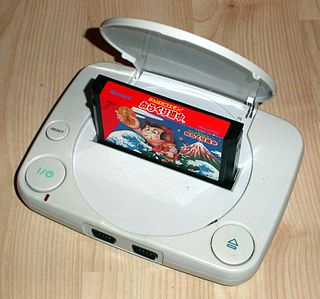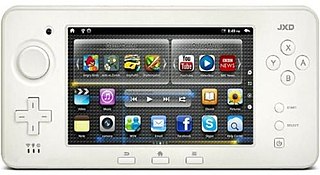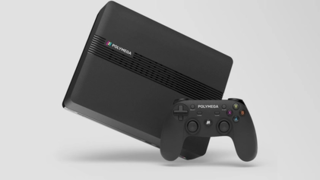
A handheld game console, or simply handheld console, is a small, portable self-contained video game console with a built-in screen, game controls and speakers. Handheld game consoles are smaller than home video game consoles and contain the console, screen, speakers, and controls in one unit, allowing players to carry them and play them at any time or place.

The Microvision is the first handheld game console that used interchangeable cartridges and in that sense is reprogrammable. It was released by the Milton Bradley Company in November 1979 for a retail price of $49.99, equivalent to $212.00 in 2023.

The WonderSwan is a handheld game console released in Japan by Bandai. It was developed by Gunpei Yokoi's company Koto Laboratory and Bandai, and was the last piece of hardware Yokoi developed before his death in 1997. Released in 1999 in the sixth generation of video game consoles, the WonderSwan and its two later models, the WonderSwan Color and SwanCrystal were officially supported until being discontinued by Bandai in 2003. During its lifespan, no variation of the WonderSwan was released outside of Japan.

The Genesis Nomad, also known as Sega Nomad, is a handheld game console manufactured by Sega and released in North America in October 1995. The Nomad is a portable variation of the Sega Genesis home video game console. It could also be used with a television set via a video port. It was based on the Mega Jet, a portable version of the home console designed for use on airline flights in Japan.

PolyStation is the popular name given to any shanzhai counterfeit video game console and Nintendo Entertainment System hardware clone that closely resembles a Sony PlayStation, particularly the PS1 variant. The cartridge slot of the PS1-clone systems is located under the lid which, on an original PlayStation, covers the disc drive.

The Game Boy is an 8-bit fourth generation handheld game console developed and manufactured by Nintendo. It was first released in Japan on April 21, 1989, in North America later the same year, and in Europe in late 1990. It was designed by the same team that developed the Game & Watch series of handheld electronic games and several Nintendo Entertainment System (NES) games: Satoru Okada, Gunpei Yokoi, and Nintendo Research & Development 1.

The Game Gadget is an open source gaming handheld that supports music and video playback, open game development, and some e-reader features.

The Neo Geo X (NGX) is a hybrid video game console manufactured by Tommo, licensed by SNK Playmore. Information about the Neo Geo X was first reported in January 2012 and later confirmed in March. It is the first Neo Geo system to be released since the discontinuation of the brand in 2004 and the third Neo Geo handheld console, following the 1999 release of the Neo Geo Pocket Color, which was supported until 2001.

The JXD S5100 is a 5-inch Android tablet and portable game console produced by JXD. It was released in 2012 and resembles Nintendo's Wii U GamePad. Unlike the previous Sony-style JXD models, the S5100 lacks shoulder buttons.
RetroN is a series of video game consoles created and developed by Hyperkin which allows users to play video games from consoles such as the Nintendo Entertainment System and the Super NES. Since the release of the RetroN 5, they have been connected via HDMI. The latest in the series, RetroN Sq, was released in 2021.
The Analogue Nt is a home video game console designed and manufactured by Analogue, designed to play games for the Nintendo Entertainment System and the Famicom.

Hyperkin is an American video game peripheral manufacturer and distributor, founded in 2006, based in Los Angeles, California. They distribute accessories for major gaming consoles, in addition to creating clone consoles that play retro games with modern resolutions and on modern devices, most notably the RetroN series of clone consoles. As with most other NES clones, Hyperkin's NES clones suffer from imperfect sound due to a design flaw in the sound hardware.

The Analogue Super Nt is an FPGA-based home video game console designed and manufactured by Analogue It is designed to be compatible with games for the Super Nintendo Entertainment System.
The Analogue Pocket is an FPGA-based handheld game console designed and manufactured by Analogue; it was announced on October 16, 2019 and released on December 13, 2021. It is designed to play games for handhelds of the fourth generation of video game consoles and earlier generations.

The Evercade is a handheld game console developed and manufactured by UK company Blaze Entertainment. It focuses on retrogaming with ROM cartridges that each contain a number of emulated games. Development began in 2018, and the console was released in May 2020, after a few delays. Upon its launch, the console offered 10 game cartridges with a combined total of 122 games.

Evercade VS is a video game console developed by UK company Blaze Entertainment. It is an upgraded home console version of the original Evercade handheld that introduces multiplayer functionality. It was released in December 2021 in Europe, and on 25 February 2022 in the United States.
The Anbernic RG351 is a Linux-based handheld game console created in China by Anbernic. The console uses a microSD card for storage and is a digital ROM-only console. It is the successor to the RG350, and has emerged as a prominent handheld console for retrogaming alongside the Retroid Pocket 2, with the screen aspect ratio of some models particularly optimized for Game Boy Advance titles. It is sold in several models with different shells and screen resolutions, but similar internal specifications. Critics have praised its quality and functionality, but criticized certain aspects of its design.

Polymega is a home video game console developed by American company Playmaji, Inc. It is a retro gaming console offering backwards compatibility with several CD-based platforms: PlayStation, TurboGrafx-CD, Neo Geo CD, Sega CD, and Sega Saturn. It also supports cartridge-based platforms, including Nintendo Entertainment System (NES), Sega Genesis, Sega 32X, Super Nintendo Entertainment System (SNES), and Nintendo 64. It includes a built-in CD drive, while separate add-ons known as Element Modules provide support for cartridge-based games.
The Anbernic RG552 is a dual-boot Linux and Android-based handheld game console created in China by Anbernic. A retrogaming emulation console, it is the successor to the RG351, and is a larger console in general, about the size of a Nintendo Switch Lite. It has more powerful hardware and increased screen size in a 5:3 aspect ratio. Critics praised the system for its build quality, but criticized its price to performance ratio, saying that it would likely be eclipsed by other systems with increased emulation capabilities such as the Ayn Odin and Retroid Pocket 2+.
The Ayn Odin is an Android-based handheld video game console created in China by the company Ayn. A retrogaming emulation and mobile gaming console, it is slightly smaller than the Nintendo Switch. It was released in three models of increasing price, the Lite, Base, and Pro. The product of a successful Indiegogo campaign, it was critically praised at the time of release as one of the most powerful handheld consoles for the price, able to reliably play games from the sixth generation of home consoles. A successor, named the Ayn Odin 2 was released in fall 2023.













